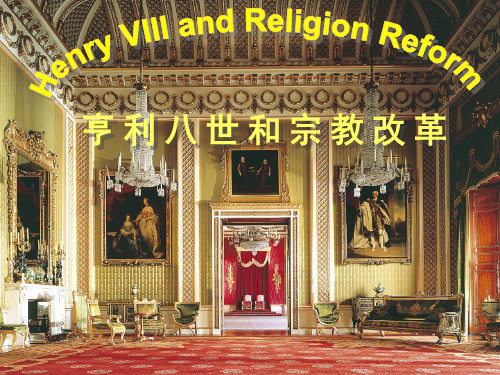Henry Ⅷ and Reform of the Church
- 格式:ppt
- 大小:586.00 KB
- 文档页数:19

第4章15世纪(1400~1550)4.1 复习笔记Ⅰ. Historical background(历史背景)(1) The Hundred Years’ War(百年战争)The Hundred Years’War continued and in 1415 at the Battle of Agincourt King Henry Ⅴ (1413~1422) defeated the French army and claimed himself the heir to the French throne.百年战争还在持续,在1415年的阿金库尔战役中,亨利5世(1413~1422)战胜了法国军队,并宣布自己是法国的继承者。
(2) The War of the Roses (1455~1485)(玫瑰战争)The War of the Roses, or the Thirty Years’ War, was a series of civil wars fought between the two great families, both of which claimed the right to the English throne. It lasted for thirty years until King Henry Ⅶ defeated Richard Ⅲ(1483~1485) at the Battle of Bosworth and ended the civil war.玫瑰战争,又叫三十年战争,是发生在两个家族之间的一系列内战,他们都宣称自己有权统治英国。
它持续了30年,直到亨利7世在博斯沃思战争(1483~1485)中打败理查德3世,内战宣告结束。
(3) The discovery of America and the new sea routes(美洲大陆和新航海线路的发现)In 1492, a Genoese mariner, Christopher Columbus (ca.1436~1506) who believed that he could reach India by sailing west, landed in America with thesupport of the Spanish sovereigns Ferdinand and Isabella.1492年,热那亚水手克里斯托弗·哥伦布相信只要一直向西航行就能到达印度,在费迪南和伊莎贝拉的支持下,他登上了美洲大陆。





英国国教,英文:Church of England,英国在宗教改革中建立的民族教会。
也称英格兰圣公会或安立甘教会。
英国国教也传播到爱尔兰、苏格兰和英属殖民地。
英国坎特伯雷大主教为各国圣公会的名义教宗。
16世纪英国专制王权与罗马教廷争夺英国教会最高统治权和经济利益的斗争加剧。
资产阶级和新贵族也觊觎教会占有的大量土地财产,这些矛盾由于教皇迟迟不批准亨利八世的离婚请求而演成公开对抗。
自1529年起亨利八世操纵议会实行自上而下的宗教改革,先后通过法令禁止向教廷纳贡,取消其最高司法权和其他种种特权。
1534年的《至尊法案》正式宣布国王为英教会的最高首脑,建立脱离罗马教廷的英国国教会。
但基本沿用旧教教义、礼仪和主教制。
爱德华六世时国教教义和仪式逐渐接近于新教。
1553年玛丽女王登位一度复辟天主教。
1558年伊丽莎白一世即位,重立英国国教会,规定官方教义和礼仪,镇压不服从国教的天主教徒和清教徒。
1563年颁布《公祷书》和《三十九条信纲》,规定英国国教的教义,以圣经为信仰的唯一原则,否认教皇的权力。
在17世纪英国革命中废除作为维护专制君主制和对抗清教运动的工具的国教会。
1660年斯图亚特王朝复辟后再次恢复国教会,并企图转向罗马旧教。
1688年政变后国教会深受加尔文教影响,逐渐变成资产阶级化的教会。
18和19世纪分别出现过提倡新教传统的福音运动和强调天主教传统的牛津运动。
这两派继续存在于圣公会.公导书公祷书(The Book of Common Prayer)是圣公会的祈祷用书。
是圣公会信仰的一个重要特征,也是保存圣公会信仰的重要途径。
公祷书不是圣经,也不是用以取代圣经的另一典籍,而是协助信徒使用和明白圣经的方法之一。
历史公祷书(The Book of Common Prayer)为英国教会克蓝玛大主教于1549年所出版的崇拜礼仪书,给所有教会使用,要全国教会遵守。
查1529年英王亨利八世称自己为英国教会的元首,克蓝玛被亨利提升为大主教,自英王亨利八世称自己为英国教会的元首后,遂展开一连串英国教会的改教工作。
书虫亨利八世和他的六位妻子英文读后感Henry VIII was a complex and fascinating figure in English history, known for his tumultuous personal life and his significant impact on the religious and political landscape of the time. As a self-proclaimed "book worm," Henry's relationship with his six wives is a captivating story that has captured the imagination of readers and historians alike.Born in 1491, Henry VIII ascended to the throne of England in 1509 at the young age of 18. From the outset, he was a powerful and charismatic ruler, determined to leave his mark on the world. However, it was his personal life that would ultimately define his legacy, as he navigated the complexities of love, marriage, and the pursuit of an elusive male heir.Henry's first wife was Catherine of Aragon, a Spanish princess whom he married in 1509. Their marriage was initially a happy one, and Catherine bore him several children, though only one, a daughter named Mary, survived to adulthood. However, as the years passed and Catherine failed to produce a male heir, Henry's affections began to wander, and he became increasingly obsessed with the idea of a male successor.This obsession led Henry to seek a way to annul his marriage to Catherine, a move that was vehemently opposed by the Catholic Church. Undeterred, Henry severed ties with the Church and established the Church of England, declaring himself the Supreme Head of the Church. This bold move paved the way for his marriage to his second wife, Anne Boleyn, in 1533.Anne Boleyn was a captivating and intelligent woman, and she quickly captured Henry's heart. However, their marriage was tumultuous, and Anne's failure to produce a male heir ultimately led to her downfall. In 1536, Henry had Anne executed on charges of adultery, incest, and treason.Undaunted, Henry moved on to his third wife, Jane Seymour, whom he married just 11 days after Anne's execution. Jane was a gentle and compliant woman, and she finally gave Henry the son he had so desperately desired – the future Edward VI. Tragically, Jane died shortly after Edward's birth, leaving Henry a widower once again.Henry's fourth wife was Anne of Cleves, a German princess whom he had married sight unseen in an effort to forge a political alliance. However, Henry was deeply disappointed with Anne's appearance and personality, and their marriage was annulled after just six months.Undeterred, Henry moved on to his fifth wife, Catherine Howard, a young and beautiful woman who captured his heart. However, their marriage was short-lived, as Catherine was eventually executed on charges of adultery.Henry's sixth and final wife was Catherine Parr, a woman of great intelligence and faith. Catherine managed to navigate the treacherous waters of Henry's court, and she even played a role in the religious reformation that was sweeping through England. However, her own life was not without its challenges, as she narrowly escaped execution on charges of heresy.Throughout his tumultuous personal life, Henry VIII remained a powerful and influential figure in English history. He was a patron of the arts and a champion of the English language, and his reign saw the birth of the Church of England and the beginnings of the English Reformation.However, Henry's legacy is also marked by his ruthlessness and his willingness to sacrifice those closest to him in pursuit of his own desires. His six wives, each with their own unique story and legacy, have become iconic figures in their own right, and their experiences have been the subject of countless books, films, and works of art.As a self-proclaimed "book worm," Henry's own relationship with literature and learning is a fascinating aspect of his life. He was a voracious reader and a patron of the arts, and his love of books and knowledge shaped his worldview and his approach to governance.In many ways, Henry VIII and his six wives represent the complexities and contradictions of human nature. They were individuals who were shaped by the political and social realities of their time, and their stories continue to captivate and inspire readers and historians alike.Overall, the story of Henry VIII and his six wives is a powerful and enduring one, a testament to the enduring power of love, ambition, and the human spirit. Whether one views Henry as a tyrant or a visionary, his legacy remains an integral part of the rich tapestry of English history.。
亨利八世统治1509年4月22日—1547年1月28日加冕日期1509年6月24日前任亨利七世继任爱德华六世皇室都铎王朝父亲亨利七世母亲约克的伊丽莎白出生1491年6月28日普拉森舍宫逝世1547年1月28日怀特霍尔宫安葬地点温莎堡人物生平亨利八世Henry VIII(1509—1547)是英国都铎王朝的第二位国王,亨利七世次子。
亨利八世在位的38年是英格兰发生重大变化的时期,其中最重要的是16世纪宗教改革。
这次改革的基本意义在国家政治方面,而不在宗教方面,核心问题是亨利八世与罗马教廷决裂,导致英国形成完全的民族国家。
这次改革从确立亨利八世与安妮博林的婚姻合法开始,到确保国王对教会的绝对统治而宣告结束。
从表面上看,宗教改革是由亨利八世个人的离婚案引起的;从实质上看,变革是在英格兰民族主义和反教权主义日益高涨的情况下实现的,并和亨利八世的对法战争和西欧的国际格局变化都有一定的联系。
他自1509年4月22日开始在位,这时英国已经逐渐从一个欧洲偏远蛮荒及以暴政著称的小国发展成为有影响的专制极权国家,他的父亲亨利七世在位时,执行睦邻友好政策,将两个女儿分别嫁给苏格兰和法国的王储,为自己长子亚瑟娶西班牙公主阿拉贡的凯瑟琳为妻。
但婚后不久他的长子因病去世,当时西班牙和法国不和,他为了维持中立不得罪西班牙王室,力图挽留长媳,经向教皇请示,(根据天主教教规夫妻结合是上帝的旨意,不允许离婚再嫁娶,丧偶再嫁也需要教皇批准。
)教皇批准可以再嫁他的次子,当时只有12岁的亨利八世。
亨利八世18岁即位并娶寡嫂凯瑟琳,但他妻子只为他生了一个女儿玛丽(后来的玛丽一世)以后几次生育的孩子都早夭,此前英国尚未有过女王,而且有迷信说法说弟娶兄嫂不吉,他又和女侍官安妮·博林产生了婚外情,他让自己的主教宰相向教皇申请离婚,因为他这次婚姻是教皇亲自批准的,这为教皇出了一个难题,因为当时教廷亦不想得罪有强大势力的西班牙。
教廷迟迟不能批准他离婚,而他的女侍官已经怀孕。